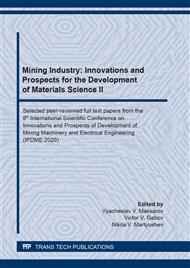p.112
p.119
p.127
p.136
p.142
p.152
p.159
p.168
p.174
Increasing the Rigidity of Thin-Walled Machine Parts Made of Aluminium Alloys by Reducing its Grain Size by Two-Way Ultrasonic Smoothing
Abstract:
The use of ultrasonic smoothing methods for metal sheet materials opens up new opportunities for improving their performance properties. The paper considers the possibility of increasing the axial stiffness of aluminium thin-walled machine parts by reducing the size of their grains and creating conditions for obtaining nanostructured formations. It has been found that the yield strength of the 8011 grade foil treated with two-way ultrasonic smoothing, depending on the depth of the hardened layer, microstructure and grain size, initially decreases to the middle section, and then increases to its largest value. According to a similar relationship, the relative elongation, i.e. the plasticity of a thin-walled part, changes which also confirms the possibility of formation of nanostructures in the studied layers. Experimental studies have established that the two-way ultrasonic treatment of multilayered plates made of aluminium 8011 grade foil with a thickness of 0.42 mm allows to provide high plasticity and to increase its axial rigidity up to 20.6%, thereby improving the manufacturability of complex machine parts from thin-walled plates by the methods of cold treatment.
Info:
Periodical:
Pages:
142-151
Citation:
Online since:
February 2021
Authors:
Price:
Сopyright:
© 2021 Trans Tech Publications Ltd. All Rights Reserved
Share:
Citation:


